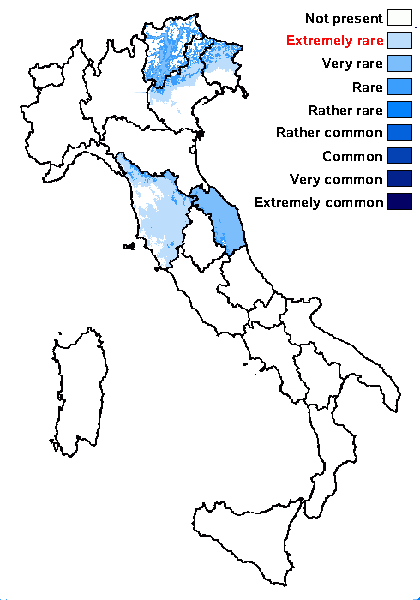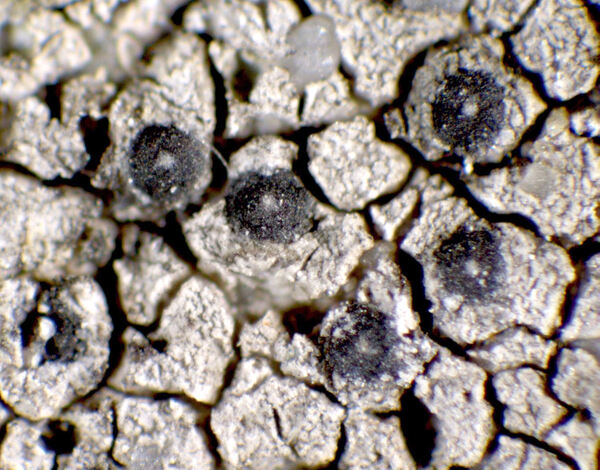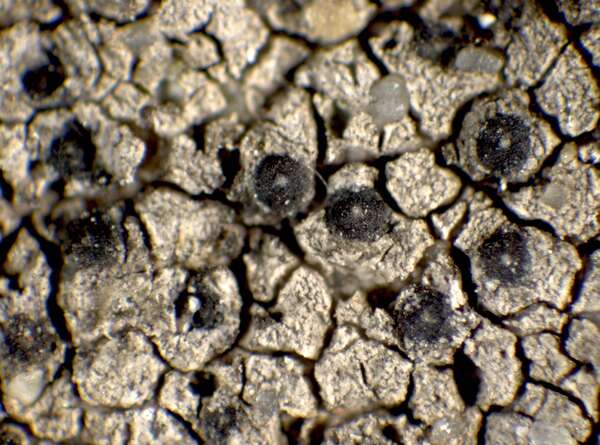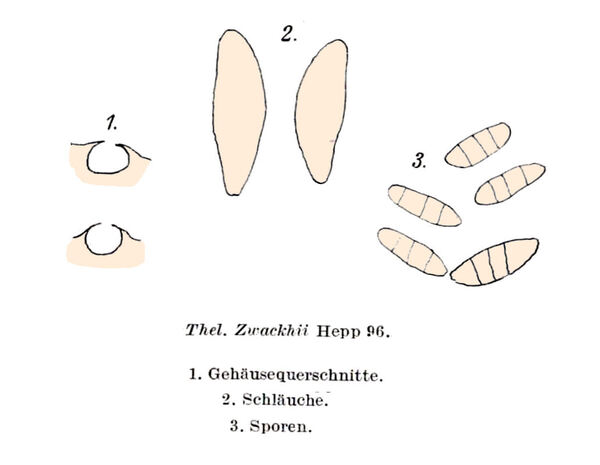Thelidium zwackhii (Hepp) A. Massal.
Framm. Lichenogr.: 16, 1855. Basionym: Sagedia zwackhii Hepp - Lich. Eur.: nr. 96, 1853.
Synonyms: Thelidium fueistingii auct. non Körb.; Thelidium microcarpum (Davies ex Leight.) A.L. Sm.; Thelidium montinii Beltr.; Thelidium sparsulum (Nyl.) A.L. Sm.; Thelidium subgelatinosum Zschacke; Thelidium velutinum auct. p.p. non (Bernh.) Körb.; Thelidium xylospilum (Nyl.) Zschacke; Verrucaria xylospila Nyl.
Distribution: N - Frl, Ven (Nascimbene & al. 2008b, Nascimbene 2008, Thüs & Nascimbene 2008), TAA (Nascimbene & al. 2021). C - Tosc, Marc (Nimis & Tretiach 1999).
Description: Thallus crustose, episubstratic, (20-)35-45(-65)μm thick, grey, whitish or brownish, continuous to slightly cracked, formed of goniocyst-like units, often with a brown pigment in the surface cells. Perithecia black, 0.1-0.25(-0.3) mm across, globose to broadly ovoid, at first more or less immersed in the thallus, finally projecting and almost sessile, sometimes collapsing into a concave shape when dry. Involucrellum absent or indistinct, rarely the exciple being slightly swollen (up to 23 μm) in the uppermost third; exciple dark brown in upper part, usually colourless in lower part; hamathecium of up to 20 μm long periphyses, interascal filaments absent; hymenial gel I+ red (I+ blue at very low concentrations of I), K/I+ blue. Asci 8-spored, ellipsoid to clavate, I-, fissitunicate, the wall thickened above, with an ocular chamber, dehiscent by extrusion of a delicate rostrum, 90-120 x 29-40 µm. Ascospores 3-septate, rarely submuriform with 1 longitudinal septum, hyaline, ellipsoid, (20-)26-36(-39) x (9-)10-13(-15) μm. Photobiont chlorococcoid. Spot tests: K-, C-, KC-, P-, UV-. Chemistry: without lichen substances.
Note: a mainly temperate, ecologically broad-ranging pioneer species found both on calcareous and on siliceous rocks, and on thin layers of soil, e.g. on walls, pebbles, etc., occasionally also in periodically submerged sites; one of the few species of the genus which occur at low altitudes in Italy. Certainly overlooked, and to be searched for more intensively throughout the country.
Growth form: Crustose
Substrata: rocks, soil, terricolous mosses, and plant debris
Photobiont: green algae other than Trentepohlia
Reproductive strategy: mainly sexual
Pioneer species
Commonnes-rarity: (info)
Alpine belt: absent
Subalpine belt: absent
Oromediterranean belt: absent
Montane belt: rare
Submediterranean belt: very rare
Padanian area: absent
Humid submediterranean belt: extremely rare
Humid mediterranean belt: absent
Dry mediterranean belt: absent

Predictive model
Herbarium samples
Growth form: Crustose
Substrata: rocks, soil, terricolous mosses, and plant debris
Photobiont: green algae other than Trentepohlia
Reproductive strategy: mainly sexual
Pioneer species
Commonnes-rarity: (info)
Alpine belt: absent
Subalpine belt: absent
Oromediterranean belt: absent
Montane belt: rare
Submediterranean belt: very rare
Padanian area: absent
Humid submediterranean belt: extremely rare
Humid mediterranean belt: absent
Dry mediterranean belt: absent

Predictive model
| Herbarium samples |
 INDEX FUNGORUM
INDEX FUNGORUM
 GBIF
GBIF
 DOLICHENS
DOLICHENS





